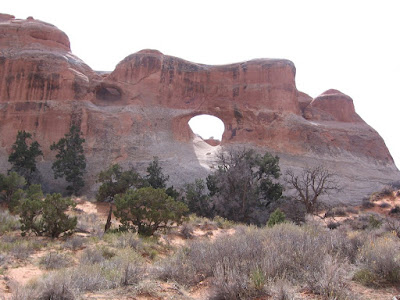The Amasa Back Trail is a popular mountain bike trail along Kane Creek Road west of Moab in southeast Utah. The trailhead parking is 5.4 miles west of the junction with Highway 191. The west turn is at the McDonald's For hikers, it is 0.5 miles of walking further east along Kane Creek Road before the trail plunges over the edge into the canyon.
The first segment of trail descends into the Kane Creek Canyon and then climbs up the south side. The length of the actual Amasa Back Trail is 3.8 miles with several options. There is an aerial photo map at the trailhead that shows the trails connected here.
The same route is also called the Cliffhanger Trail and it is a very difficult motorized trail. In the first 100 yards there is a 3 foot cliff to get past along with several other steep difficult ledges. These obstacles are all easy for hikers.
After crossing the canyon and climbing up the other side, there is a side trail to the right marked with a rock cairn that is not shown on the area maps. This side trail climbs up a drainage, crosses around the drainage head and continues up to a ledge that overlooks the first segment of trail.
There is a good petroglyph panel along the ledge that features a large featureless human figure, an owl and several mountain sheep. This panel is visible from the trailhead with binoculars.
Mountain sheep are a common image for petroglyphs but an owl is unusual. It took me about 1:00 hour to arrive here from the parking area. The route wasn't completely obvious and I spent a few minutes looking for the way up. The descent back to the main trail took 0:15 minutes. I noticed two minor panels before the main panel.
As the trail turns away from Kane Creek there are several monument type formations. The route continues to climb steadily. The desert vegetation includes scattered Pinon Pines and Utah Junipers with Black Brush and Mormon Tea shrubs.
At the higher elevations, the fins of the Behind the Rocks area become visible and the La Sal Mountains peak over the top.
After 2.0 miles on the trail, there is a side trail leading 0.7 miles northeast to a view point. The main trail leads 0.8 miles northwest to junctions with other trails, and at least 1.0 mile beyond the junction. I stopped about 0.2 miles along the side trail at a high point. It took me 2:20 hours to arrive at this point. From here, there are wide views to the north over the Colorado River and toward the Poison Spider Mesa area.
My return hike of 2.7 downhill miles to the parking area took 1:20 hours. My total hike took 3:45 hours for about 6 miles. I hiked on a 65 F degree late October day and carried 3 liters of water. I saw 8 mountain bikers during my hike and one group of motorized riders that were struggling to get started.








































